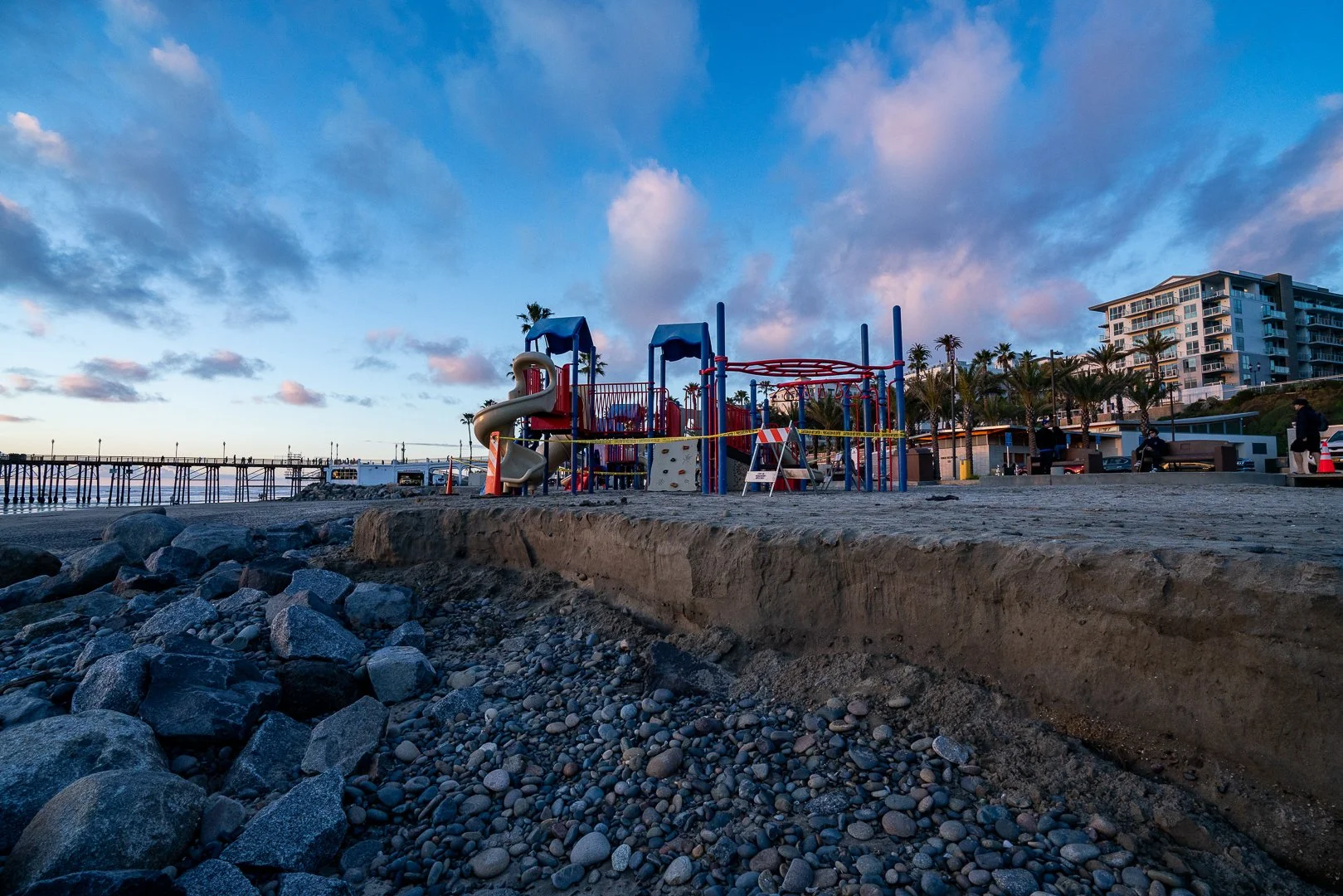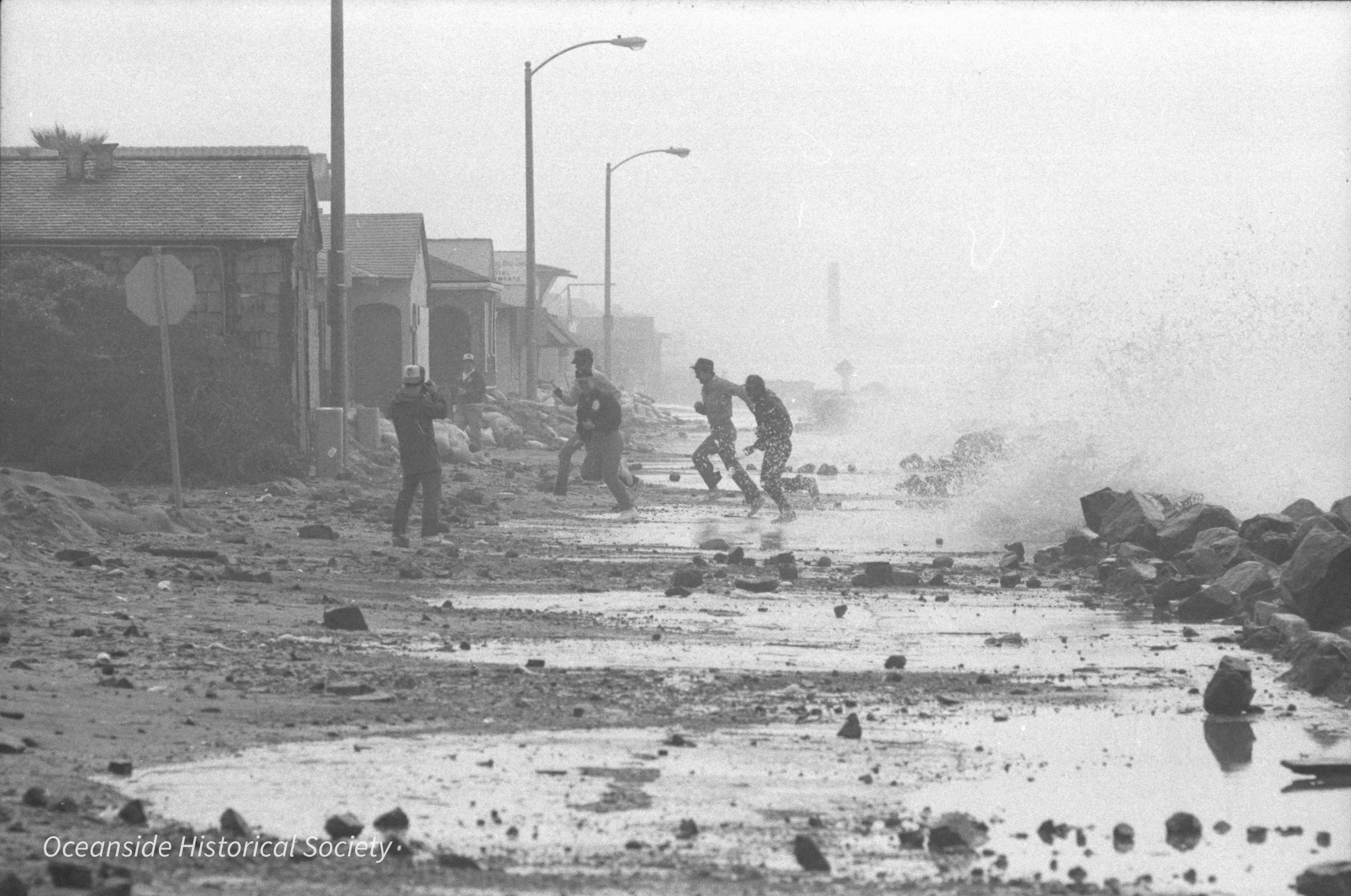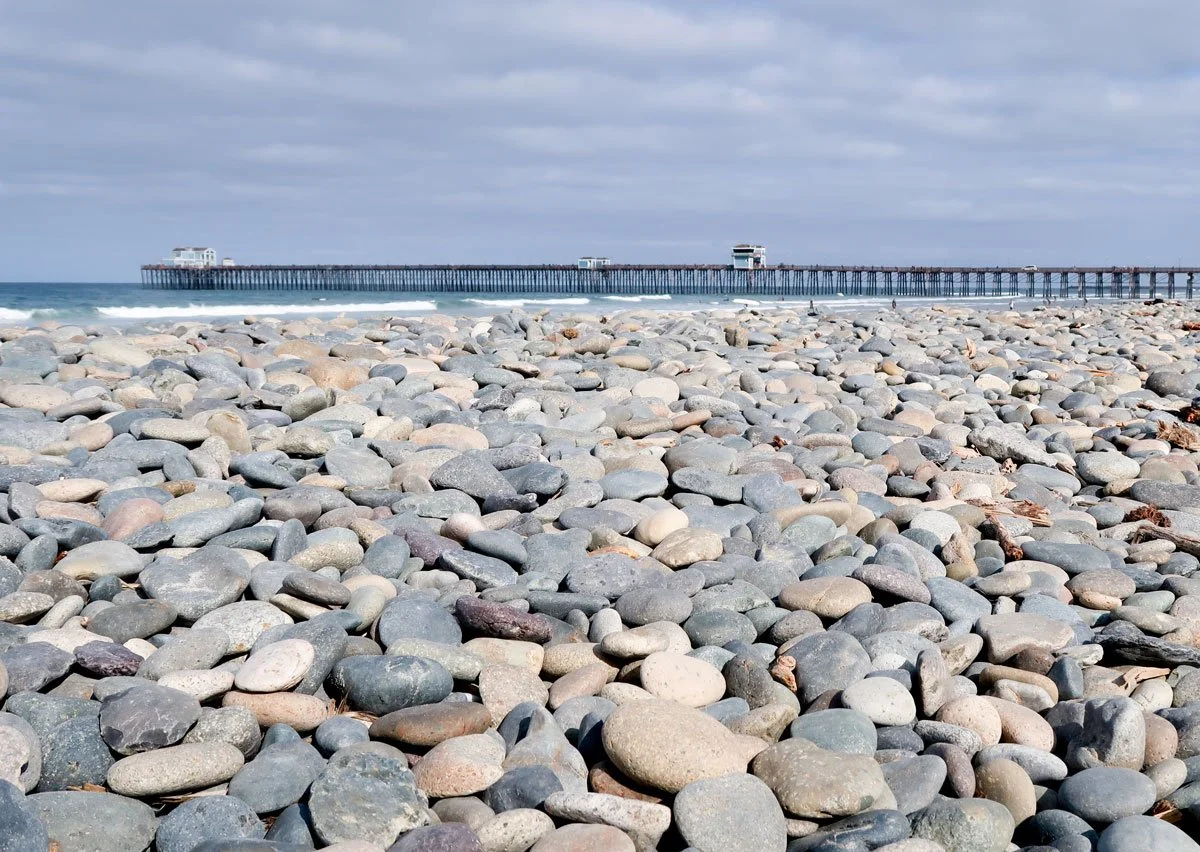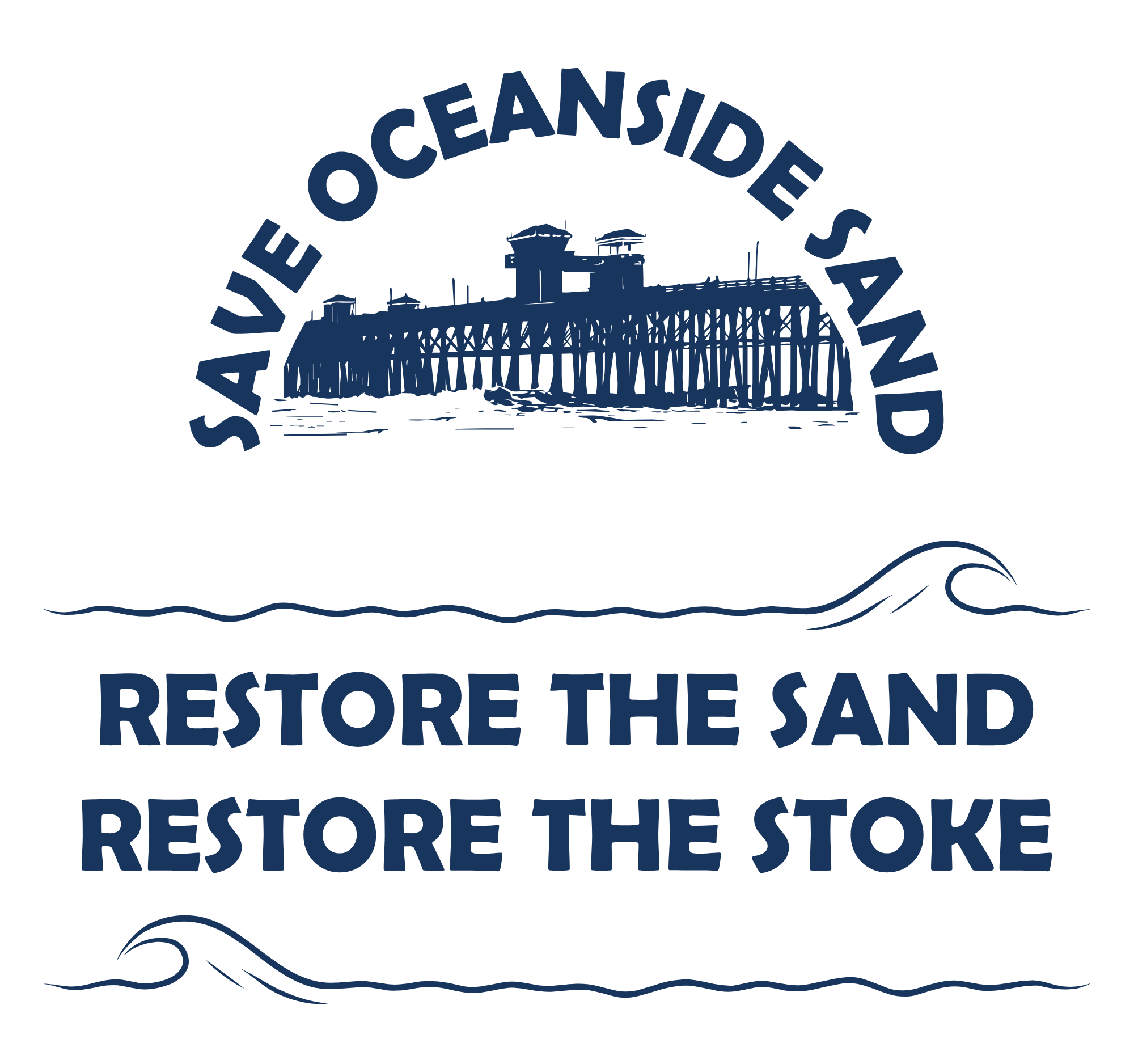
OCEANSIDE’S SHORELINE IS IN A CRISIS, AND IT DID NOT HAPPEN OVERNIGHT
Here’s what we know…
For the past 100 years, a series of man-made decisions have disrupted the natural flow of sand to our coastline.
What started as necessary or well-intentioned changes – the Camp Pendleton Harbor Complex, Henshaw Dam, the San Luis Rey River flood control project, and development – have snowballed into a full-scale shoreline erosion emergency.
Today, many of Oceanside’s beaches are reduced to cobble and concrete. At high tide, there’s barely room to walk, let alone surf, sunbathe, or build a sandcastle.
And the worst part? We’ve known this was coming for decades.Despite what some may say, coastal erosion in Oceanside is not what you would call “natural.”
Since the 1940s, one decision after another has disrupted the natural flow of sand to Oceanside’s beaches — and we have been paying for it ever since.
100 YEARS OF EROSION
〰️
100 YEARS OF EROSION 〰️
LATE 1980’s
SAND BYPASS SYSTEM
A sand bypass system was built on the Del Mar Breakwater to offset sand erosion due to the Camp Pendleton Harbor Complex. It was meant to act like Mother Nature’s conveyor belt to transport sand to Oceanside’s sand starved beaches to the south. A federally funded project, the system operated from 1989 - 1993. By 1996, the system was decommissioned, having fallen into disrepair and lacking necessary funding to continue the project.
1923
HENSHAW DAM
Located on the San Luis Rey River, Henshaw Dam was completed in 1923. It was originally built to create Lake Henshaw and provide water for agricultural irrigation. Currently owned by the Vista Irrigation District, its capacity was reduced due to seismic concerns in 1978. The dam has significantly reduced the river’s sediment flow to Oceanside’s beaches.
1942
DEL MAR JETTY & BOAT BASIN
The federal government built the Del Mar Jetty and Boat Basin in conjunction with the establishment of Camp Pendleton during World War II to provide a harbor facility for the base. This has disrupted sand transport in the Oceanside littoral cell, inadvertently forming a sand fillet (accumulation) to the north of the Del Mar Jetty. Today it is estimated that 7.5 million cubic yards of sand are trapped there.
1963
HARBOR COMPLEX
Oceanside built a small-craft harbor, including a 300 foot groin and floodwall, that has further disrupted the natural flow of sand down the coast. While millions of cubic yards of sand were initially added to Oceanside’s beaches during construction, the long-term impact has been to contribute to the steady erosion of shoreline south of the harbor. Sand loss has caused the beaches south of the Harbor Complex to retreat as much as 6.6 feet per year in some areas.
2001 & 2012
RBSP I & II
SANDAG led two major sand projects—Regional Beach Sand Project I & II—that brought in millions of cubic yards of offshore sand to nourish regional beaches. Oceanside received over 700,000 cubic yards of sand in total, helping temporarily widen our coastline. The goal was to slow erosion and improve coastal resilience through regular regional nourishment. But the reality is it didn’t last - and it’s time for another one.
2020 - PRESENT
SAND NOURISHMENT & RETENTION PILOT PROJECT - (RE:BEACH)
The City of Oceanside launched a multi-phase effort to address long-term beach erosion. After completing the feasibility study, the City began exploring local sand sources and innovative ways to hold sand in place (retention). Through the international RE:BEACH design competition, the City selected the “Living Speed Bumps” concept—two small artificial headlands and an offshore artificial reef. These constructs will stabilize sand on the back beach and slow down nearshore erosive forces.
THE BIG 5
Reasons Why We’re Losing Our Sand in Oceanside
Sand Flow Blocked By the Harbor Complex
Completion of the Camp Pendleton Boat Basin in 1943 was followed by the addition of the Oceanside small-craft harbor in 1963. This Harbor Complex, which includes the massive Camp Pendleton Del Mar Jetty, blocks the natural southward movement of sand, effectively starving Oceanside’s beaches. Some experts believe the impact reaches further south.
Failed Solutions
Oceanside has tried to fight shoreline erosion — with limited success. Over 21 million cubic yards of sand have been placed on our beaches since the 1960s. Nevertheless, without sand retention systems in place, most of it simply washed away.
Development of the Coastline
Development, channelized creeks, seawalls and rock revetments have impacted the natural erosion process of our bluffs and affected the natural shoreline features that once helped replenish and/or maintain our beaches. Efforts to protect infrastructure and property can be a catch-22 situation.
River Dam & Altered Watershed
The Henshaw Dam and other upstream alterations have cut off one of our biggest sources of new sand — the San Luis Rey River. What used to be a reliable delivery system for beach-building sediment has been reduced to a trickle.
Rising Seas + Bigger Storms
Wider, sandy beaches serve as a protective buffer and provide shoreline resiliency. With many areas of Oceanside’s beaches having little to no dry beach during the majority of the tidal cycle, wave events are impacting coastal infrastructure with greater frequency and severity, resulting in the need for repairs and improvements to shoreline protection systems. Projected sea level rise threatens to make these conditions worse.
WHAT’S BEEN TRIED — AND WHY IT DIDN’T WORK
Millions have been spent restoring Oceanside’s beaches, but still they disappeared.
The problem isn’t just erosion; it’s the lack of sand retention.
Strategy
1. Annual harbor dredging to clear navigation channel
2. Regional Beach Sand Projects I & II (2001, 2012)
3. The late 1980s sand bypass system
4. Seawalls & rock revetments
What Happened
1. United States Army Corps disposes of sediment on the beach.
2. Added total of 700K cubic yards of sand south of the Pier.
3. Built system to mimic natural sand transport
4. Protection of infrastructure & property
Why It Fell Short
1. The sediment is too fine (it is small grain), which erodes very quickly.
2. Projects were relatively short-lived without retention.
3. Mechanical failures & lack of funding – left abandoned
4. Accelerates erosion & blocks beach access
“This isn’t just a sand issue. It’s a shoreline survival issue.”-SOS Communications Director, Charlie BowenWe’ve Studied the Problem.
NOW IT’S TIME TO FIX IT.
In 2020, the City of Oceanside launched Phase 1 of a project to identify feasible solutions to protect the beach from long-term erosion. That independent study was completed in 2021 and recommended 4 solution alternatives, as opposed to doing nothing.
Those alternatives were also evaluated in comparison to each other based on technical performance, financial and environmental criteria. Based on the study’s recommendations, the City conducted further public outreach that culminated in the international RE:BEACH Design Competition, including a series of 3 public workshops. A winning design was selected through this competition, and it was approved unanimously by the Oceanside City Council in January 2023.
RE:BEACH is an innovative sand nourishment and retention pilot project. Engineering design, as well as environmental compliance and permitting, will be completed in 2026 for a shovel-ready project. In 2025, SANDAG selected RE:BEACH as the regional sand retention pilot project.
We know what’s causing the problem. We’ve seen what doesn’t work. Now we need to act on what does.
OCEANSIDE’S BEACHES CAN BE SAVED — IF WE ACT NOW
Save Oceanside Sand is pushing forward with a clear, three-part strategy:
SOS is advocating for local authorities to secure immediate sand replenishment that protects and restores our shoreline while long-term solutions are developed.
SOS fully supports nature-based sand retention solutions, like the City of Oceanside’s innovative RE:BEACH Oceanside Pilot Project to ensure lasting beach resilience.
As an independent organization, SOS is working collaboratively with the City of Oceanside, other agencies, and legislators to push for dedicated funding, long-term planning, and policy changes that prioritize beach restoration for Oceanside.
Check out what we’ve accomplished.
Let’s stop the cycle of erosion and inaction — and fight for a shoreline that future generations can enjoy.













